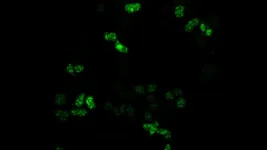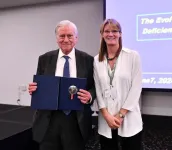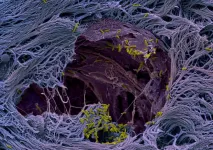(Press-News.org) FOR IMMEDIATE RELEASE
By super cooling a molecule on the surface of brain cells down to about minus 180 degrees Celsius — nearly twice as cold as the coldest places in Antarctica — scientists at Johns Hopkins Medicine say they have determined how a widely-used epilepsy drug works to dampen the excitability of brain cells and help to control, although not cure, seizures.
The research, published June 4 in Nature Structural & Molecular Biology, identifies critical connections between activity of the epilepsy drug perampanel and the resulting movements of the AMPA receptor — a brain cell surface molecule. The researchers say the findings could eventually help with designing new drugs that target the receptor to treat other neurological conditions such as Alzheimer’s disease, schizophrenia, learning disabilities, brain cancers called glioblastoma and chronic pain.
The AMPA receptor plays a critical role for one of the brain’s most abundant neurotransmitters — glutamate — which activates brain cells (neurons) by connecting with a protein on the cell surface (AMPA) in a Pac-man-like connection, in which AMPA receptors engulf glutamate.
Up to four glutamate molecules can bind to a single AMPA receptor. The connection enables a flood of ions (positively-charged particles) to enter the neuron and activate (excite) it.
“AMPA receptors and glutamate are necessary for most aspects of life, including the processes of learning, memory and encoding experiences,” says Edward Twomey, Ph.D., assistant professor of biophysics and biophysical chemistry at the Johns Hopkins University School of Medicine. “Most neurological diseases trace back in some way to AMPA receptors and glutamate.”
Twomey was approached by neuroscientist Richard Huganir, Ph.D., who has been studying AMPA receptors for 40 years, to collaborate on research to better understand the receptors’ structure and their glutamate binding process.
Overactivation (excitation) of AMPA receptors is known to cause epilepsy. Perampanel, which targets the AMPA receptor, is the only medicine approved by the U.S. Food and Drug Administration to target AMPA receptors, but many pharmaceutical companies are working on similar compounds, the researchers say.
“This drug was initially discovered in the 1980s, and its precise mechanism has been a long standing mystery,” says Twomey.
“We know that this drug doesn’t block or get stuck in the receptor’s ion channels,” says Huganir, Bloomberg Distinguished Professor of Neuroscience and Psychological and Brain Sciences and director of the Solomon H. Snyder Department of Neuroscience. Other scientists had found where perampanel binds to AMPA receptors in pockets around the ion channel but had not found the way that connection disrupts ion flow.
To study the mechanism, the researchers turned to cryo-electron microscopy (cryoEM), which has evolved in the last two decades as a powerful tool to study structures a million times smaller than the width of a human hair.
Johns Hopkins postdoctoral fellow W. Dylan Hale, Ph.D., working in the Twomey and Huganir labs, performed most of the experiments and analysis in the Beckman Center for CryoEM at Johns Hopkins, where they super chill biological molecules and take images at various timepoints.
For the study, the researchers analyzed millions of images of AMPA receptors in brain cells from mice and rat models and their interaction with the originally discovered version of the perampanel drug, GYKI-52466. “These interactions happen at a super tiny scale, about 1 to 2 angstroms,” says Twomey. An angstrom is 1 10 billionth of a meter.
They looked at the GYKI-52466 drug’s binding, with and without glutamate. They also performed electrical recordings of the ion flow, and physiology studies in mice to complement the cryoEM images.
The scientists used artificial intelligence and machine learning tools to average and combine the cryoEM images into a 3D reconstruction of the receptor.
When glutamate binds to the AMPA receptor in one of four positions, a strand of the receptor comes down and pulls open the ion channel enabling the flow of ions, akin to how a pull chain releases water from a shower head.
The researchers found that two of the four glutamate binding positions are the most important in the GYKI-52466 drug’s ability to block the ion flow.
“The drug binds to the AMPA receptor and prevents the ion channel from opening by blocking the ability of glutamate to pull on the strand that opens the ion channel,” says Twomey. “It seems to decouple the glutamate binding regions from each other and put the receptor into a desensitized state.”
Huganir also plans to work with Twomey to use cryoEM to study what happens to the AMPA receptor when it’s mutated.
“We want to know what’s wrong with the receptor’s structure that disables its function,” Huganir says. “In theory, we could develop drugs to make the receptor more active to treat conditions in which the receptor’s structure is altered.”
In addition to Hale, Twomey and Huganir, researchers who contributed to the work are Alejandra Montaño Romero and Albert Lau at Johns Hopkins, and Cuauhtemoc Gonzalez and Vasanthi Jayaraman at the University of Texas Health Science Center at Houston.
Funding support for the study was provided by the Searle Scholars Program, the Diana Helis Henry Medical Research Foundation, and the National Institutes of Health (R37 NS036715, R01 GM094495, R35 GM122528, F99NS130928, K99 MH132811).
DOI: 10.1038/s41594-024-01328-0
END
Super-chilled brain cell molecules reveal how epilepsy drug works
Finding may advance creation of new drugs that target AMPA receptors to treat brain cancer, pain and Alzheimer’s disease
2024-06-10
ELSE PRESS RELEASES FROM THIS DATE:
Benefits of failure are overrated
2024-06-10
The platitude that failure leads to success may be both inaccurate and damaging to society, according to research published by the American Psychological Association.
Researchers conducted 11 experiments with more than 1,800 participants across many domains and compared national statistics to the participants’ responses. In one experiment, participants vastly overestimated the percentage of prospective nurses, lawyers and teachers who pass licensing exams after previously failing them.
“People expect success to follow failure much more often than it actually does,” said lead researcher Lauren Eskreis-Winkler, PhD, an assistant ...
NUTRITION 2024 showcases groundbreaking research on what we eat and why it matters
2024-06-10
Don’t miss your chance to be among the first to hear breaking news in food and nutrition science at NUTRITION 2024. The annual flagship meeting of the American Society for Nutrition will be held June 29–July 2 at McCormick Place in Chicago.
Reporters and bloggers are invited to explore the meeting schedule and register for a complimentary press pass to attend.
The meeting will feature stimulating discussions, exciting research announcements and updates from groups shaping the nutrition and health policies that affect us all. Highlights include:
Diet and exercise performance – As the ...
Icahn School of Medicine at Mount Sinai awarded $21 million NIH grant to advance understanding of aging-related hormone
2024-06-10
New York, NY [June 10, 2024]—Researchers at the Icahn School of Medicine at Mount Sinai have been awarded a $21 million grant from the National Institute on Aging (NIA) of the National Institutes of Health (NIH), to further advance understanding of an aging-related hormone known as follicle-stimulating hormone (FSH), including its potential role in obesity, osteoporosis, and Alzheimer’s disease. The work could lead to the development of new treatments for these and other conditions involving aging.
This is a collaborative ...
RNA splicing’s spotters
2024-06-10
Bodybuilders and cellular mechanisms agree generating protein is a heavy lift. To complete the task, cells rely on complexes called spliceosomes. These molecular machines snip extra bits out of our genes’ RNA copies and piece together precise instructions for protein-building. When the splicing process goes awry, it can result in diseases like cancer or spinal muscular atrophy. Cold Spring Harbor Laboratory (CSHL) Professor Adrian Krainer helped develop the first FDA-approved treatment for this devastating genetic disorder. Now, his team has discovered that two important regulator proteins work together ...
Clinical trial shows promising results in a two-drug combination that curbs methamphetamine use
2024-06-10
A clinical trial on a two-drug therapy for methamphetamine use disorder reduced use of the highly addictive drug for up to 12 weeks after initiation of treatment, UCLA-led research suggests.
Participants in the ADAPT-2 clinical trial who received a combination of injectable naltrexone plus extended-release oral bupropion (NTX+BUPN) had a 27% increase in methamphetamine-negative urine tests, indicating reduced usage. By contrast, the placebo group had an 11% increase in negative tests.
The study will be published in the peer-reviewed journal Addiction.
“These ...
Gut microbes from aged mice induce inflammation in young mice, study finds
2024-06-10
CHAMPAIGN, Ill. — When scientists transplanted the gut microbes of aged mice into young “germ-free” mice — raised to have no gut microbes of their own — the recipient mice experienced an increase in inflammation that parallels inflammatory processes associated with aging in humans. Young germ-free mice transplanted with microbes from other young mice had no such increase.
The findings suggest that changes to the gut microbiome play a role in the systemwide inflammation that often occurs ...
Valentin Fuster, MD, Ph.D., received 2024 Distinguished Award from European Society for Clinical Investigation (ESCI)
2024-06-10
The European Society for Clinical Investigation (ESCI) is awarding Valentin Fuster, MD, PhD, President of Mount Sinai Heart and Physician-in-Chief of The Mount Sinai Hospital, its ESCI Distinguished Medal for 2024. He received this honor during the ESCI Annual Scientific Meeting in Barcelona, Spain, during a special ceremony on Friday, June 7.
The ESCI Medal is awarded yearly for outstanding achievements in clinical investigation and for the teaching of young scientists and medical specialists.
This prestigious recognition highlights Dr. Fuster’s significant contributions to the worldwide field of cardiology. Dr. Fuster’s work has been ...
Planetary Health Diet associated with lower risk of premature death, lower environmental impact
2024-06-10
Embargoed for release: Monday, June 10, 7:00 AM ET
Key takeaways:
People whose diets most closely adhered to the Planetary Health Diet (PHD) had 30% lower risk of premature death compared to those with the lowest adherence.
Every major cause of death, including cancer, heart disease, and lung disease, was lower with greater adherence to this dietary pattern.
Diets adhering to the PHD pattern had substantially lower environmental impact, including 29% lower greenhouse gas emissions and 51% less land use.
Boston, MA—People who eat a healthy, sustainable diet may ...
Improved prime editing system makes gene-sized edits in human cells at therapeutic levels
2024-06-10
Scientists at the Broad Institute of MIT and Harvard have improved a gene-editing technology that is now capable of inserting or substituting entire genes in the genome in human cells efficiently enough to be potentially useful for therapeutic applications.
The advance, from the lab of Broad core institute member David Liu, could one day help researchers develop a single gene therapy for diseases such as cystic fibrosis that are caused by one of hundreds or thousands of different mutations in a gene. Using this new approach, they would insert a healthy copy of the gene at its native location in the genome, rather than having to create a different ...
Lung organoids unveil secret: How pathogens infect human lung tissue
2024-06-10
How do pathogens invade the lungs? Using human lung microtissues, a team at the Biozentrum of the University of Basel has uncovered the strategy used by a dangerous pathogen. The bacterium targets specific lung cells and has developed a sophisticated strategy to break through the lungs’ line of defense.
Earlier this year, the WHO published a list of twelve of the world’s most dangerous bacterial pathogens that are resistant to multiple antibiotics and pose a grave threat to human health. This list includes Pseudomonas aeruginosa, a much-feared nosocomial pathogen ...
LAST 30 PRESS RELEASES:
Injectable breast ‘implant’ offers alternative to traditional surgeries
Neuroscientists devise formulas to measure multilingualism
New prostate cancer trial seeks to reduce toxicity without sacrificing efficacy
Geometry shapes life
A CRISPR screen reveals many previously unrecognized genes required for brain development and a new neurodevelopmental disorder
Hot flush treatment has anti-breast cancer activity, study finds
Securing AI systems against growing cybersecurity threats
Longest observation of an active solar region
Why nail-biting, procrastination and other self-sabotaging behaviors are rooted in survival instincts
Regional variations in mechanical properties of porcine leptomeninges
Artificial empathy in therapy and healthcare: advancements in interpersonal interaction technologies
Why some brains switch gears more efficiently than others
UVA’s Jundong Li wins ICDM’S 2025 Tao Li Award for data mining, machine learning
UVA’s low-power, high-performance computer power player Mircea Stan earns National Academy of Inventors fellowship
Not playing by the rules: USU researcher explores filamentous algae dynamics in rivers
Do our body clocks influence our risk of dementia?
Anthropologists offer new evidence of bipedalism in long-debated fossil discovery
Safer receipt paper from wood
Dosage-sensitive genes suggest no whole-genome duplications in ancestral angiosperm
First ancient human herpesvirus genomes document their deep history with humans
Why Some Bacteria Survive Antibiotics and How to Stop Them - New study reveals that bacteria can survive antibiotic treatment through two fundamentally different “shutdown modes”
UCLA study links scar healing to dangerous placenta condition
CHANGE-seq-BE finds off-target changes in the genome from base editors
The Journal of Nuclear Medicine Ahead-of-Print Tip Sheet: January 2, 2026
Delayed or absent first dose of measles, mumps, and rubella vaccination
Trends in US preterm birth rates by household income and race and ethnicity
Study identifies potential biomarker linked to progression and brain inflammation in multiple sclerosis
Many mothers in Norway do not show up for postnatal check-ups
Researchers want to find out why quick clay is so unstable
Superradiant spins show teamwork at the quantum scale
[Press-News.org] Super-chilled brain cell molecules reveal how epilepsy drug worksFinding may advance creation of new drugs that target AMPA receptors to treat brain cancer, pain and Alzheimer’s disease




